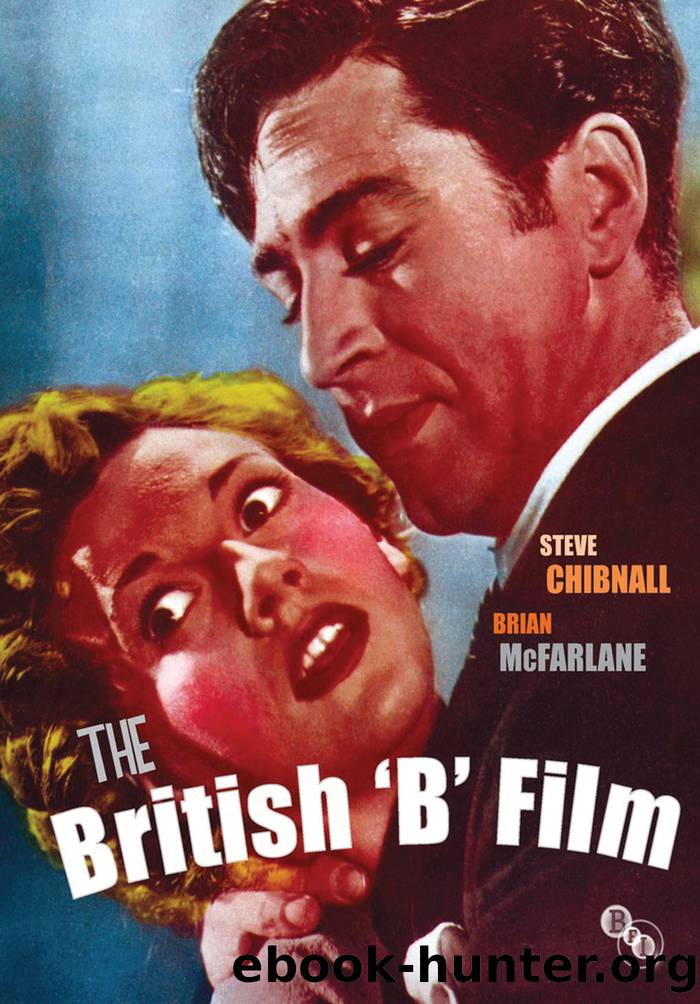The British 'B' Film by Chibnall Steve;McFarlane Brian;

Author:Chibnall, Steve;McFarlane, Brian;
Language: eng
Format: epub
Publisher: BFI Publishing
Published: 2009-09-15T00:00:00+00:00
Hardboiled hero: American import, Wayne Morris, takes no nonsense in Henry Cassâs The Crooked Sky (1956)
One Hollywood import with considerable star value, particularly in the context of the crime genre, was George Raft, who was brought over to star alongside Britainâs Sally Gray in Escape Route (1953), directed by the Anglo-American partnership of Peter Graham Scott and Seymour Friedman. It was a London-set Cold War thriller in which British and American agents, working together, track down the kidnappers of some important boffins. The film made outstanding use of London locations from the West End to docklands, but the suspense was not augmented by the emotional monotone of Raftâs performance, which was as wooden as his floating namesake. Sometimes, American leads seemed under-prepared for the culture shock of British film-making. William Lundigan, for instance, was actually expecting to star in a motor-racing film when he discovered that he had to take to the ocean for Vernon Sewellâs Dangerous Voyage (1935). He had to be virtually press-ganged onto Sewellâs boat from his comfortable suite at the Dorchester Hotel.16 As the British âBâ film reached its terminally decadent phase in 1963, Lawrence Huntington directed American actor Macdonald Carey in the highly self-referential Stranglehold. In a fitting swan-song for the importation of transatlantic âBâ players, Carey played a Hollywood actor specialising in gangster parts who is employed to make a film in a British studio. Ironically, although these tough, wise-cracking Yanks often looked out of place in the English suburbs and shires, they were needed to bring a sense of genre authenticity to British attempts to emulate the sort of hardboiled crime cinema that been developed in Hollywood rather than Boreham Wood.
Leading women
There are fewer âBâ film leading actresses who established a toe-hold in main features. Among those who started in âAâ films were such Rank contract players as Rona Anderson, Honor Blackman, Hazel Court, Sonia Holm, Jane Hylton, Lana Morris, Barbara Murray and Susan Shaw, most of them alumni of the much-derided Charm School, and most of them deserving to be better remembered than that. Honor Blackman (b. 1925), after second leads in such Gainsborough numbers as So Long at the Fair (1950), drifted into Bs in the 1950s, providing a touch of cool in Suspended Alibi (1956) and Account Rendered (1957), though neither role tapped the sexiness she would demonstrate in the next decade in Goldfinger (1964) and TVâs The Avengers (1962â4), when she escaped for good from the âBâ film trade. Red-headed Hazel Court (1926â2008) appeared in ten âAâ films of the 1940s, including the young female lead in the popular Holiday Camp (1947), without quite becoming a star. She then spent most of the 1950s in âBâ films, including two for Vernon Sewell (Ghost Ship; Counterspy, 1953, both with then-husband Dermot Walsh) and three for Charles Saunders (The Scarlet Web, 1954; The Narrowing Circle, Behind the Headlines, 1956), before finding a niche as Technicolor queen of several horror films, including Hammerâs The Curse of Frankenstein (1957), before leaving Britain for Hollywood in the mid-1960s.
Download
This site does not store any files on its server. We only index and link to content provided by other sites. Please contact the content providers to delete copyright contents if any and email us, we'll remove relevant links or contents immediately.
Verus Israel: Study of the Relations Between Christians and Jews in the Roman Empire, AD 135-425 by Marcel Simon(552)
Infocracy by Byung-Chul Han(540)
Caesar Rules: The Emperor in the Changing Roman World (c. 50 BC â AD 565) by Olivier Hekster(530)
Europe, Strategy and Armed Forces by Sven Biscop Jo Coelmont(477)
Banned in the U.S.A. : A Reference Guide to Book Censorship in Schools and Public Libraries by Herbert N. Foerstel(446)
Reading Colonial Japan by Mason Michele;Lee Helen;(443)
The Roman World 44 BC-AD 180 by Martin Goodman(437)
Give Me Liberty, Seventh Edition by Foner Eric & DuVal Kathleen & McGirr Lisa(436)
DS001-THE MAN OF BRONZE by J.R.A(423)
The Dangerous Life and Ideas of Diogenes the Cynic by Jean-Manuel Roubineau(417)
The Oxford History of World War II by Richard Overy(414)
Introducing Christian Ethics by Samuel Wells and Ben Quash with Rebekah Eklund(412)
american english file 1 student book 3rd edition by Unknown(412)
Imperial Rome AD 193 - 284 by Ando Clifford(409)
Basic japanese A grammar and workbook by Unknown(392)
Literary Mathematics by Michael Gavin;(373)
Language Hacking Mandarin by Benny Lewis & Dr. Licheng Gu(352)
How to Reach the 9.0 in IELTS Academic Reading by IELTS Medical(333)
The Oxford History of the Renaissance by Campbell Gordon;(332)
